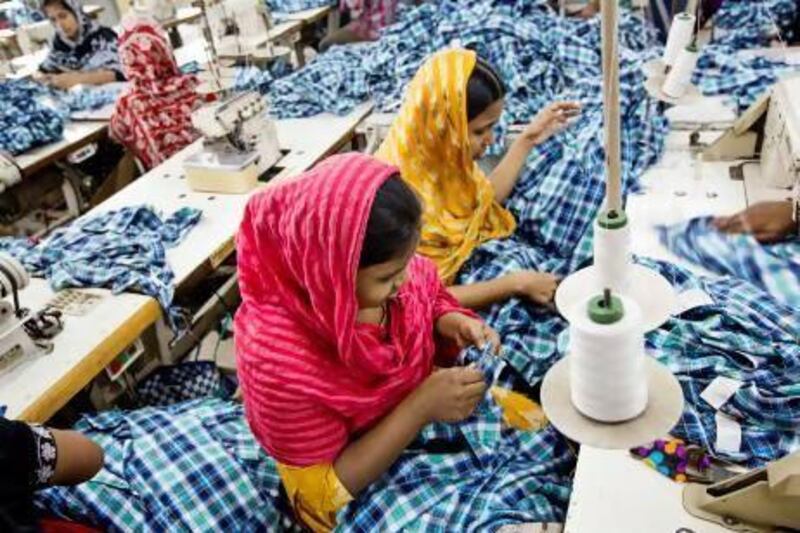Retailers from around the world claimed a victory this week in forcing the government of Bangladesh to concede to a series of new rights and safeguards for factory workers. The move was made after a second high-profile garment factory disaster claimed more than 1,100 lives.
But it is hard to see how the proposals announced in response to this terrible display of neglect on behalf of the factory owner will change anything of significance for Bangladeshi workers.
In Bangladesh there is already a government body that sets minimum wages and standards for workers in every sector.
The National Minimum Wage Board even has a special office to make sure the most vulnerable workers in the country, those in the garment-making industry, get special attention. And they do, these much-put- upon employees get almost double the national average monthly wage.
Sounds great, doesn't it? But in actual fact those garment workers get just US$37 a month and their counterparts in all other industries get just $19 a month. Bangladeshi factory workers are the lowest paid in the world and have to labour under some of the worst working conditions in the world.
They are paid so little that even some Chinese manufacturers - who used to pay the lowest wages - are now outsourcing manufacturing to Bangladesh.
The oversight on conditions and benefits, such as they are, is also pretty meaningless seeing as how the recent deadly catastrophes - including the fire last November that killed more than 110 people - happened under their auspices.
There are 4.5 million garment factory workers at more than 5,000 factories in Bangladesh in a $20 billion a year industry that has become the mainstay of the country's feeble economy.
They make the clothes stocked by just about every retailer on the high street in this country, the United States, United Kingdom, across Europe and many parts of Asia.
H&M, the Swedish clothing retailer, is by far the biggest client of the Bangladeshi garment industry and as such, is responsible for exerting the pressure on the Bangladeshi government that led to the changes promised this week.
The H&M endorsed plan includes a legal framework that governs annual fire and building inspections, among other measures. The Bangladeshi government, meanwhile, has promised to review minimum wages and benefits, legal requirements on safety and union representation.
But despite the celebrations among western activists and the progress claimed by the likes of H&M, the measures are still a long way from implementation. Many of them - indeed the most significant of them - must be debated and voted on by the Bangladeshi government. And who knows how long that process will take or what the measures will look like on the other side of it?
More important, though, is the fact that many of the world's biggest clothing retailers, such as Wal-Mart and Gap, have not only refused to sign up to the H&M plan for fear of legal ramifications, but they have drafted their own alternative plans.
Wal-Mart wants to set up its own factory inspection plan using a private auditing company based in Europe. It doesn't want to pay for those audits though, rather it thinks a voluntary plan for factory owners to sign up to will be better with the costs voluntarily passed on through normal pricing mechanisms.
This is essentially the sort of system that exists today and it doesn't work.
Gap hasn't finished its alternative plan yet, and also suggests it might sign up to the H&M plan once its lawyers have finished working on "six sentences" that it is not comfortable with.
If and when all these different plans and mechanisms are complete and if and when they are implemented, it is highly unlikely they will all be able to coexist efficiently and do the job they are designed to do - that is keep factory workers safe and ensure they earn a living wage.
The real problem, of course, is a much larger one and that is the fact that the globalised economy relies upon ultra low- cost manufacturing to function.
And by ultra low-cost manufacturing we mean the sort of manufacturing environment that results in factories collapsing with hundreds of workers inside such as we have seen in Bangladesh. Or working conditions so tough that the employee suicide rate is higher than anywhere else on Earth, which we saw at an electronics factory in China last year.
We have become addicted to this cheap manufacturing and it is not good for us. Yes we have access to all the phones, designer jeans and handbags we want at an affordable price, but at what cost?
And as with all addictions, we are unable to kick this habit for many more serious reasons than our insatiable desire for more cheap consumer goods.
So many years of abuse have resulted in incurable systemic changes to the global economy.
Exporting our manufacturing to these ultra low-cost locales is all that is keeping hyperinflation from our doors. We have no choice but to stick with it unless we want yet another decade of economic catastrophe.
And the likes of H&M and Wal-Mart certainly wouldn't be able to exist in their current forms without it, so it is hardly likely that very much is going to change.
jdoran@thenational.ae
The sad truth of our reliance on low-cost manufacturing
Retailers have claimed a victory in forcing the government of Bangladesh to concede to new rights and safeguards for factory workers after the factory disaster which claimed 1,100 lives. But it is hard to see how the proposals will change anything of significance.

Editor's picks
More from the national




